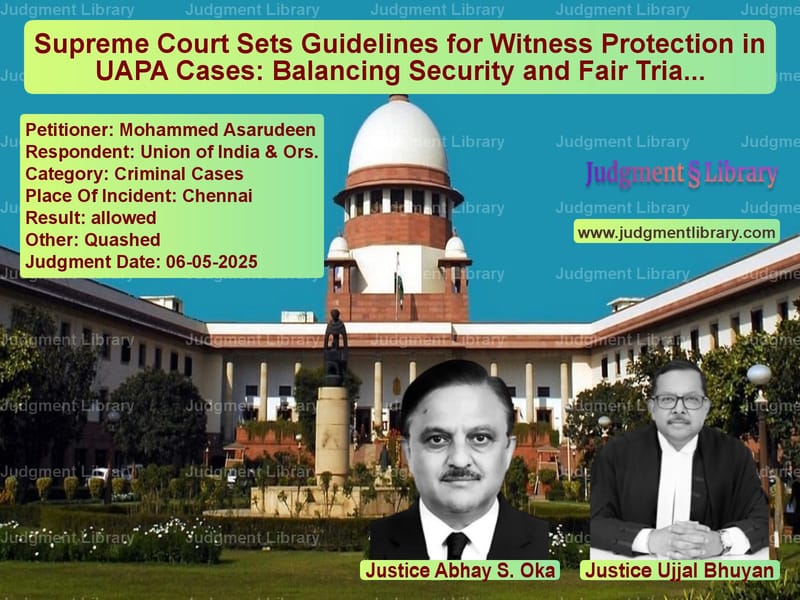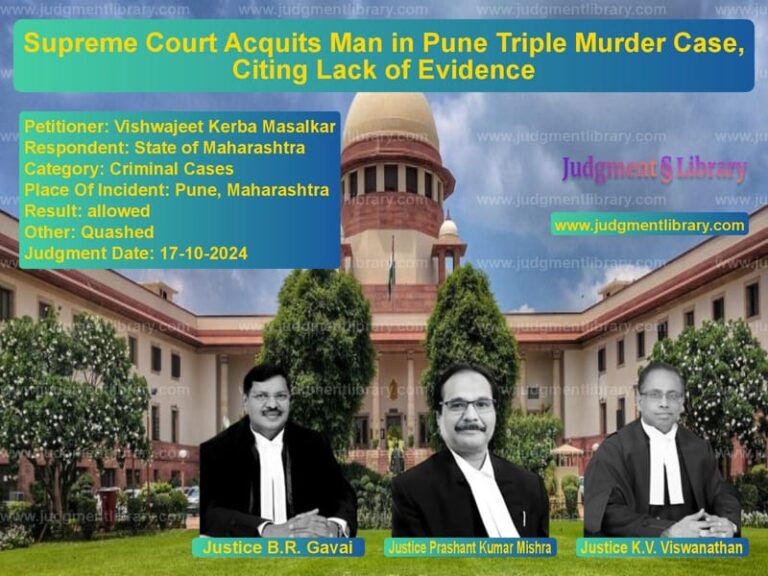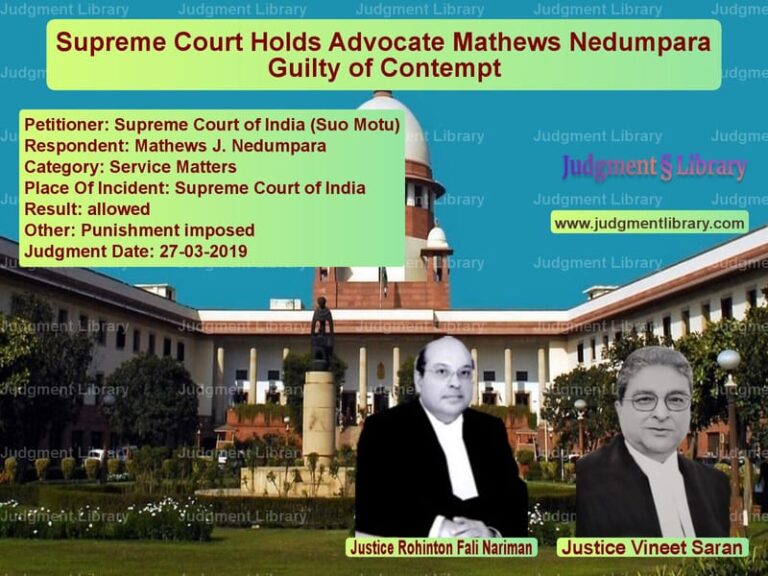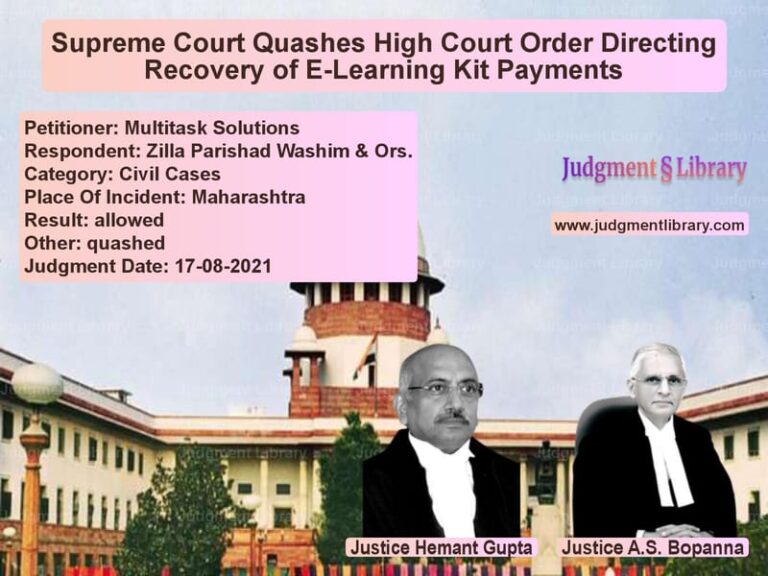Supreme Court Sets Guidelines for Witness Protection in UAPA Cases: Balancing Security and Fair Trial Rights
In a landmark judgment that carefully balances witness protection with the fundamental rights of the accused, the Supreme Court of India has established crucial guidelines for protecting witnesses in cases under the Unlawful Activities (Prevention) Act. The case involving Mohammed Asarudeen, who was being tried by the Special Court for NIA cases in Chennai, brought to the forefront the delicate interplay between ensuring witness safety and preserving the accused’s right to a fair trial.
The legal battle began when the National Investigation Agency sought protection for multiple witnesses in a case where Asarudeen faced serious charges including Sections 120B, 143, 147, 148, 302 read with 149 of the Indian Penal Code and Section 15 read with Sections 16, 18, 18B, 19 and 20 of the UAPA. The Special Public Prosecutor of NIA filed an application invoking powers under Section 44 of the UAPA read with Section 17 of the NIA Act for witness protection, specifically seeking “to issue necessary order or orders for not supplying of copies of the statement recorded under Section 161 of Cr.P.C. in respect of Protected Witnesses to the accused persons or their advocate/legal counsel.”
The Special Court, in its order dated August 21, 2019, allowed the application with specific conditions. It permitted the prosecution “to hide the identity and address of the witnesses” and directed that “the original statements u/s 161 of Cr.P.C. in respect of those witnesses will be opened from the sealed cover on the date of examination of the concerned witness and after examination-in-chief is over, the statement of such witness shall be supplied to the accused immediately.”
When the NIA challenged this order before the High Court, the court interfered with the third condition, setting aside the provision that allowed accused persons to receive witness statements after examination-in-chief. This led Asarudeen to approach the Supreme Court, arguing that both lower courts had failed to properly apply the legal requirements for witness protection.
The Legal Framework and Competing Arguments
At the heart of this case were Section 44 of the UAPA and Section 17 of the NIA Act, which provide for witness protection. Section 44(2) specifically states that “A court, if on an application made by a witness in any proceeding before it or by the Public Prosecutor in relation to such witness or on its own motion, is satisfied that the life of such witness is in danger, it may, for reasons to be recorded in writing, take such measures as it deems fit for keeping the identity and address of such witness secret.”
The appellant’s senior counsel made a fundamental argument that “the satisfaction which is required to be recorded in terms of sub-section 2 of Section 44 of UAPA and sub-section 2 of Section 17 of the NIA Act, has not been recorded by the Special Court.” He further submitted that “notwithstanding the failure of the Special Court to record the satisfaction, as clause (3) of paragraph 6 of the order of the Special Court protected the appellant, he did not challenge the order.”
The Additional Solicitor General, representing the Union of India, countered that “the satisfaction required to be recorded in terms of sub-section 2 of Section 44 of the UAPA and sub-section 2 of Section 17 of the NIA Act has been clearly recorded in paragraph 5 of the order of the Special Court.” He asserted that “the Special Court could have always directed that the copies of the statements of the protected witnesses should not be given to the accused even after the examination-in-chief of the said witnesses is over.”
The ASG made a significant additional submission “that when application under sub-section 2 of Section 44 of the UAPA or sub-section 2 of Section 17 of NIA is heard by the Special Court, the accused have no right of hearing.” He relied on the Witness Protection Scheme, 2018, approved by the Supreme Court in Mahender Chawla & Ors. vs. Union of India & Ors.
The Supreme Court’s Elaborate Reasoning
The Supreme Court, in its judgment delivered by Justice Abhay S. Oka and Justice Ujjal Bhuyan, began by establishing the fundamental principle that “The normal rule is that the accused is entitled to the copies of the statements of witnesses recorded by the police during the investigation unless the concerned Court exercises the power under sub-section 6 of Section 173 of the Cr.P.C. read with first proviso of Section 207 of the Cr.P.C.”
The Court emphasized that “Sub-section 2 of Section 44 of the UAPA can be invoked by a prosecution witness or by the Public Prosecutor. In a given case, even the Special Court can exercise this power suo motu. The first condition precedent for the exercise of powers under sub-section 2 of Section 44 of UAPA is the recording of the satisfaction by the Special Court that the life of the concerned witness is in danger. Obviously, this satisfaction must be recorded based on the material available before the Special Court.”
The judgment made a crucial distinction in the statutory framework, noting that “It is pertinent to note that out of four sub-sections of Section 44 (Section 17 of the NIA), only sub-section 1 starts with a non-obstante clause.” This observation was significant because it indicated that sub-section 2 does not override other statutory provisions in the same manner as sub-section 1.
Read also: https://judgmentlibrary.com/supreme-court-upholds-gang-rape-conviction-but-acquits-under-sc-st-act/
The Court established a two-stage process for applying witness protection measures: “After recording the satisfaction, the second stage comes into play. It is not that in every case that after such satisfaction is recorded, the Court can pass an order prohibiting the prosecution from providing a copy of the entire statement of the prosecution witnesses till the conclusion of the trial. The Court has to apply its mind considering the material on record, what kind of measures should be adopted for keeping the identity and address of such a witness, secret. While deciding what kind of measures should be adopted, the Court must record brief reasons.”
In a significant clarification, the Court stated that “On plain reading of sub-section 2 of Section 44 of the UAPA, the Court has to apply its mind in relation to danger to a particular witness. An omnibus application cannot be made by the Special Public Prosecutor for the grant of protection under sub-section 2 of Section 44 for all witnesses or a number of witnesses. Even if an application is made in respect of more than one witness, specific averments in relation to every witness must be made in the application.”
The Court was categorical about strict compliance requirements: “In our view, sub-section 2 of Section 44 of the UAPA (sub-section 2 of Section 17 of NIA) must be strictly complied with, as the exercise of the power may affect the right of the accused to defend.”
Application to the Present Case
Examining the specific case before them, the Court found that “the Special Court was dealing with an application where the prayer under sub-section 2 of Section 44 of UAPA was made in respect of a large number of witnesses. The Special Court has not considered the case of each witness separately regarding the possible dangers to their lives. The Court has also not recorded satisfaction based on material that the life of a particular witness is in danger. A very general observation has been made in paragraph 5 that, in the interests of justice, the Court feels that the identity of the witnesses can be hidden till the examination in chief of the witnesses is recorded.”
The Court concluded that “the order of the Special Court cannot be sustained as even the first satisfaction, which is required to be recorded in terms of sub-section 2 of Section 44 of UAPA, has not been recorded.”
Regarding the High Court’s approach, the Supreme Court was equally critical: “This observation of the High Court completely ignores the second part of sub-section 2 of Section 44 of the UAPA. Even assuming that a satisfaction was recorded that there was a danger to the life of a witness, the Court was required to apply its mind to decide what measures should be taken to protect the witness as regards his identity, address and name, etc. The Court must apply its mind to decide what measures should be taken and record brief reasons for taking such measures.”
The Court firmly rejected the High Court’s blanket approach: “Therefore, in every case where the first part of satisfaction under sub-section 2 of Section 44 is recorded, the Court cannot pass a blanket order as suggested by the High Court in paragraph 21. The Special Court must be conscious of the fact that sub-section 2 of Section 44 of UAPA is an exception to the normal rule.”
Right to Hearing and Natural Justice
In addressing the ASG’s submission about the accused having no right to hearing, the Court provided important clarity: “We do not find that sub-section 2 of Section 44 of UAPA and sub-section 2 of Section 17 of the NIA Act exclude the principles of natural justice. As observed earlier, it is for the Court to decide whether the nature of the material regarding the threat perception relied upon, should be disclosed to the accused. The Court has a power to direct that the material should not be disclosed to the accused. The accused has a right of hearing on the application under sub-section 2 of Section 44 of the UAPA, but obviously, till orders are passed by the Court on the application and subject to such orders, the accused is not entitled to know the identity of the witnesses in respect of whom the application is made.”
The Court acknowledged the practical concerns: “If, during the pendency of the application, the identity of the witness is disclosed in any manner, the very purpose of the power conferred on sub-section 2 of Section 44 of the UAPA will be lost.”
Final Directions and Broader Implications
The Supreme Court set aside both the Special Court’s order and the High Court’s judgment, disposing of the NIA’s application. However, the Court granted “time of eight weeks to the Special Public Prosecutor to file a proper application to invoke provisions of Section 44(2) and Section 17(2).”
The Court provided interim protection: “If such applications are made in relation to particular witnesses within eight weeks from today, till the disposal of the applications, subject to the orders which may be passed by the Special Court on the applications, the identity of the witnesses shall not be disclosed in any manner.”
This judgment establishes several crucial principles that will guide lower courts in handling witness protection applications under UAPA and similar legislation. First, it reinforces that witness protection measures are exceptions to the normal rule of disclosure and must be applied judiciously. Second, it mandates individualized assessment for each witness rather than blanket orders. Third, it affirms the accused’s right to hearing while balancing practical concerns about witness safety.
The Supreme Court’s approach demonstrates a careful balancing act – protecting witnesses from genuine threats while ensuring that the accused’s fundamental right to defend themselves is not unduly compromised. By requiring specific satisfaction based on material for each witness and individualized protective measures, the Court has struck a balance that serves both the interests of justice and the requirements of a fair trial.
This judgment will likely have far-reaching implications for terrorism cases and other serious offenses where witness protection is crucial, ensuring that such protections are granted through a transparent, reasoned process rather than as routine procedural measures. The emphasis on recording satisfaction based on material and providing brief reasons for protective measures creates accountability and prevents the misuse of witness protection provisions to undermine the accused’s defense rights.
Petitioner Name: Mohammed Asarudeen.Respondent Name: Union of India & Ors..Judgment By: Justice Abhay S. Oka, Justice Ujjal Bhuyan.Place Of Incident: Chennai.Judgment Date: 06-05-2025.Result: allowed.
Don’t miss out on the full details! Download the complete judgment in PDF format below and gain valuable insights instantly!
Download Judgment: mohammed-asarudeen-vs-union-of-india-&-ors-supreme-court-of-india-judgment-dated-06-05-2025.pdf
Directly Download Judgment: Directly download this Judgment
See all petitions in Terrorist Activities
See all petitions in Bail and Anticipatory Bail
See all petitions in Fundamental Rights
See all petitions in Public Interest Litigation
See all petitions in Judgment by Abhay S. Oka
See all petitions in Judgment by Ujjal Bhuyan
See all petitions in allowed
See all petitions in Quashed
See all petitions in supreme court of India judgments May 2025
See all petitions in 2025 judgments
See all posts in Criminal Cases Category
See all allowed petitions in Criminal Cases Category
See all Dismissed petitions in Criminal Cases Category
See all partially allowed petitions in Criminal Cases Category







